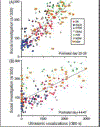Sociability versus empathy in adolescent mice: Different or distinctive?
- PMID: 37614811
- PMCID: PMC10443922
- DOI: 10.1016/j.lmot.2023.101892
Sociability versus empathy in adolescent mice: Different or distinctive?
Abstract
In recent years, a growing number of pre-clinical studies have made use of the social abilities of mice, asking how gene variants (e.g., null, transgenic or mutant alleles) give rise to abnormalities in neurodevelopment. Two distinct courses of research provide the foundation for these studies. One course has mostly focused on how we can assess "sociability" using metrics, often automated, to quantitate mouse approach and withdrawal responses to a variety of social stimuli. The other course has focused on psychobiological constructs that underlie the socio-emotional capacities of mice, including motivation, reward and empathy. Critically, we know little about how measures of mouse sociability align with their underlying socio-emotional capacities. In the present work, we compared the expression of sociability in adolescent mice from several strains versus a precisely defined behavioral model of empathy that makes use of a vicarious fear learning paradigm. Despite substantial strain-dependent variation within each behavioral domain, we found little evidence of a relationship between these social phenotypes (i.e., the rank order of strain differences was unique for each test). By contrast, emission of ultrasonic vocalizations was highly associated with sociability, suggesting that these two measures reflect the same underlying construct. Taken together, our results indicate that sociability and vicarious fear learning are not manifestations of a single, overarching social trait. These findings thus underscore the necessity for a robust and diverse set of measures when using laboratory mice to model the social dimensions of neuropsychiatric disorders.
Keywords: BTBR; fear conditioning; social neuroscience; vicarious fear learning, autism.
Figures








Similar articles
-
The Visible Burrow System: A behavioral paradigm to assess sociability and social withdrawal in BTBR and C57BL/6J mice strains.Behav Brain Res. 2018 May 15;344:9-19. doi: 10.1016/j.bbr.2018.02.003. Epub 2018 Feb 7. Behav Brain Res. 2018. PMID: 29425919
-
Variability in empathic fear response among 11 inbred strains of mice.Genes Brain Behav. 2016 Feb;15(2):231-42. doi: 10.1111/gbb.12278. Epub 2016 Jan 12. Genes Brain Behav. 2016. PMID: 26690560
-
Co-learning facilitates memory in mice: a new avenue in social neuroscience.Neuropharmacology. 2013 Jan;64:283-93. doi: 10.1016/j.neuropharm.2012.06.054. Epub 2012 Jul 6. Neuropharmacology. 2013. PMID: 22776545
-
Social Fear Learning: from Animal Models to Human Function.Trends Cogn Sci. 2017 Jul;21(7):546-555. doi: 10.1016/j.tics.2017.04.010. Epub 2017 May 22. Trends Cogn Sci. 2017. PMID: 28545935 Free PMC article. Review.
-
BALB/c mice: low sociability and other phenotypes that may be relevant to autism.Behav Brain Res. 2007 Jan 10;176(1):53-65. doi: 10.1016/j.bbr.2006.06.025. Epub 2006 Aug 4. Behav Brain Res. 2007. PMID: 16890300 Review.
References
-
- Allsop SA, Wichmann R, Mills F, Burgos-Robles A, Chang CJ, Felix-Ortiz AC, Vienne A, Beyeler A, Izadmehr EM, Glober G, Cum MI, Stergiadou J, Anandalingam KK, Farris K, Namburi P, Leppla CA, Weddington JC, Nieh EH, Smith AC, . . . Tye, K. M. (2018). Corticoamygdala Transfer of Socially Derived Information Gates Observational Learning. Cell, 173(6), 1329–1342.e18. 10.1016/j.cell.2018.04.004 - DOI - PMC - PubMed
-
- Bardo MT, Valone JM, Robinet PM, Shaw WB, & Dwoskin LP (1999). Environmental enrichment enhances the stimulant effect of intravenous amphetamine: Search for a cellular mechanism in the nucleus accumbens. Psychobiology, 27(2), 292–299. 10.3758/bf03332123 - DOI
-
- Barrio VD, Aluja A, & García LF (2004). Relationship between empathy and the big five personality traits in a sample of spanish adolescents. Social Behavior and Personality: An International Journal, 32(7), 677–681. 10.2224/sbp.2004.32.7.677 - DOI
Grants and funding
LinkOut - more resources
Full Text Sources
